

Julianna Richie - NanoJapan 2014
Southern Illinois University, Carbondale
Major: Physics
Class Standing: Sophomore
Anticipated Graduation: May 2016
NanoJapan Research Lab: Femotosecond Spectroscopy Group, Prof. Keshav Dani, Okinawa Institute of Science & Technology
NanoJapan Research Project: ![]()

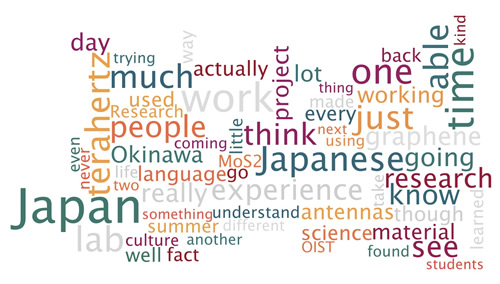
Why NanoJapan?
I first became interested in Japan in 2011 when the tsunamis hit the island. I became interested not because of the destruction that resulted from this disaster, but rather because of the reconstruction that followed. Seeing pictures of people of all ages and socio-economic backgrounds helping each other out in the street by providing food, shelter, and clothing was extraordinary to me. The rebuilding of the island was not assigned to public service workers, but rather was taken on by every citizen of the community despite age or profession. That kind of culture spoke volumes to me and I knew that I wanted to be a part of it someday.
NanoJapan was an excellent opportunity for me to become involved in that culture, however, it is beneficial to all students for another reason- international collaboration. With science evolving and changing with every passing day, it becomes obvious that we as a scientific community should begin working together. This sharing of knowledge should not stop at the lab doors; it should be shared with the world. Getting students involved in this type of international collaborations is of the utmost importance for the future of science.
I am looking forward to building my skills in international networking as well as learning new techniques for approaching problems. I’ve been told Japan is a beautiful and friendly place and cannot wait to get started exploring.
My goals for this summer are to:
Meaning of My NanoJapan Experience
The meaning of NanoJapan is not to go do science in a foreign country. It’s not about making foreign connections. No, it’s not about the cultural experience, or the trying to survive in a Japanese grocery store. It’s about all of that tied up into one big ball of nonsense condensed into 12 weeks. It’s a chance to grow and learn and - yes, even play! NanoJapan is a very serious program however it’s also a great time to relax and enjoy life.
My favorite experience in Japan was… the homestay visit in Kyushu.
Before I left for Japan I wish I had…packed a pillow.
While I was in Japan I wish I had…been more forceful about visiting Meisei Gakuen (Tokyo School for the Deaf). This was something I wanted to do and then pushed off until it was too late.
My initial reaction to Tokyo was, “wow!” It amazes me that there are so many people here and yet the streets are so clean. I feel completely safe walking through the streets by myself and this is due entirely to the friendly demeanor of everyone I happen to meet. I definitely expected people to be less accepting of foreigners, but that has not been my experience whatsoever. One thing that I did not expect is the seemingly total lack of vegetables and fruits. There are definitely vegetables and fruits here, but they are very expensive and not usually included in meals. This is definitely different than the US where I am able to get fruits and veggies easily for a relatively low cost.
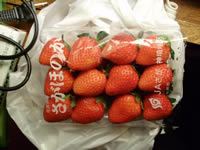
Expensive Fruits: A picture of the most symmetric bunch of strawberries I have ever seen. Like I said, fruits and vegetables here are expensive. This little bunch cost me the equivalent of roughly $3.22. However, these berries were well worth the money and coupled with peanut butter crackers, made for an excellent dinner (I am beginning to miss Western style food).
Another thing that I did not expect was the sheer amount of dogs here on Tokyo. Every time I go out exploring I will see no less than fifteen dogs an hour. People here are always walking their dogs. Mostly, I see small dogs however, I did see a standard poodle once and there is also another large dog on the roof of an apartment building behind the building that likes to howl and run about the roof. There are also quite a few specialty pet shops in which cute toys, clothes, leashes, and healthy snacks can be bought for these pampered pooches.
Language class is difficult for me. I am slowly picking up on the language and it irritates me simply because I usually am very good at picking up languages. I never had this much trouble in my Spanish class in high school, or my ASL class in college. I think the reason for the difficulty is that so much information is being thrown my way every day and I’m experiencing sensory over load. However, I definitely have been trying to use my language skills in every day interactions. During the KIP discussion, I introduced myself in full Japanese; it must have been okay because the KIP students smiled very big and said it sounded okay. I also was able to use my new found skills at the 100 yen store on Friday. I only had a large bill on me so I asked the clerk if it would be okay to pay with it. And considering I walked out with a laundry bag and detergent, I would say that it all worked out.
The evening discussion with the (Japanese) KIP students was interesting. I was impressed by their language skills and at how willing they were to make mistakes and ask questions. However, the topic was one that seemed a bit wide scoped. The topic actually lead to many side discussions that related to the topic but not to the issues at hand. For instance, we talked a bit about organ transplants. The topic is related to the bio-engineering aspect in that the discussion was cued by the fact that a heart had been printed on a 3D printer and worked, however, the discussion soon switched to traditional transplants and how that worked in America. Unfortunately, I was unable to trade information with the KIP students, and really regret not being able to do so. Though I do look forward to our next discussion and plan on exchanging my business card with them so that we might keep in touch throughout the summer- especially since finding out that one of the students, Yoji, will be moving to Okinawa this summer.
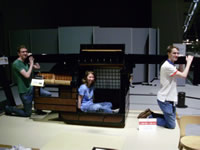
Edo Tokyo Museum!: As you can clearly see, I have convinced the others that I am their emperor and should be treated as such. This was trip was a lot of fun and I am very glad that everyone in the group seems to get along so well that we can joke like this together. Also, that basket was pretty comfortable- it even had armrests!
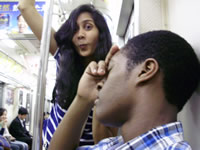
Chris Claims to be Awake, but this photo would say Otherwise: You can see that we’re taking care of each other!
Intro to Nanoscience Lectures & Lab Tours at the University of Tokyo
Kono-sensei provided our group with a brief introduction to the concepts that will be explored in each of the projects going on this summer. This lecture combined concepts from electricity and magnetism with concepts that would be found in relativity, such as Ohm’s law and how it could be utilized when studying quantum dots. I found the whiteboard time most helpful in lecture, because I was able to more clearly understand what was going on in the presentation when I saw it drawn out.
The lab tours (at the University of Tokyo) were exceptionally wonderful. The only problem was that it was sometimes very hard to hear what each of the experiments were as the labs had very loud equipment. I especially enjoyed hearing about electric double layer transistors (EDLTs) and graphene sheet synthesis as I was at least somewhat familiar with the subject material. I think it is very cool that one of the labs was able to grow a 5mm sheet of graphene and are striving to create one that is 1cm in relative diameter. The lecture about EDLTs was extremely entertaining though I do wish I better understood the differences between transistors and capacitors as the set up looks similar to experiments I have conducted with electric double layer capacitors (EDLCs).
Research Project Overview at the Femotosecond Spectroscopy Group, Prof. Keshav Dani, Okinawa Institute of Science & Technology
The material for my project will be Molybdenum disulfide (MoS2). This material is a semiconducting material and can be a 2D structure, however, I believe that my project will be focusing on synthesizing and utilizing nanotubes made with this material, making its dimensionality 3. I will be studying optical properties of these tubes as I will be using femtosecond terahertz, Raman, and photo luminescence spectroscopy. This project will involve the synthesis of MoS2 and the subsequent fabrication and characteristics of terahertz antennas. This material has several applications including terahertz antennas and energy storage.
The most recent paper published by my lab that I was able to get readily was published in 2012 and is entitled, “Intraband conductivity response in graphene observed using ultrafast infrared-pump, visible-probe spectroscopy.” The purpose of the experiment was to study photocarriers in graphene to further characterize the material. It was found that graphene possesses a relativistic characterization after being excited by a visible pump-probe. The experiment was done using chemical vapor deposition grown graphene that was then transferred from a copper substrate onto a Magnesium Oxide substrate. The sample was then studied using Raman spectroscopy to ensure monolayer graphene had been achieved during growth as well as ensuring that no hole-doping had occurred. Once this was confirmed, the sample underwent ultrafast visible pump-probe experimentation. At 250 kHz and 800nm, the graphene was excited via pump-probe resulted in an electron-hole imbalance around 100fs after excitation. The experiment resulted in intraband interactions relying upon frequency and interband interactions are given by a step function. Because of these properties, graphene is a promising relativistic material and will have applications in relativistic physics, photonics, and plasmonics.
This experiment was interesting to be because I have mainly worked with graphene up until this point in my research. I find it extremely interesting that graphene has relativistic properties when considering electron transfer in the material.
When ever I use public transportation here, the rules are vastly different from those in the U.S. Whenever I take a bus back home, the people on it are very spread out. Sometimes, they will take up two seats and allow for another person to stand rather than move their bag. Here in Tokyo, everyone is very much compacted to the physical space that their body takes. If they’re sitting, their bags are placed on their lap. They sit in one seat and one seat only- even if they’ve fallen asleep! People who are standing are often unable to move when the subway is crowded. They keep their bags attached to them and try to squeeze together in order to make room for one more person. When the trains aren’t crowded, those standing will often place their bags on the provided racks above the seats. For the most part, these rules are followed no matter what time of day it is. Another thing I notice is that people will give up their seats if someone who really needs it gets on the train. I have never seen those kinds of things in America. Though, I was once forcefully offered a seat on a bus by an international student and we both ended up standing until I got off at the next stop. However, I don’t think that example counts as he was not really displaying the American culture.
If the trains aren’t too crowded, people often do small activities to pass the time. They’ll listen to music, play on their phones or Nintendos, and read magazines. If a few friends are together, they will talk quietly amongst themselves, but never loudly enough so that it disturbs other riders. Honestly, the activities on the trains and subways are what you would expect them to be - quiet and self contained. There are a lot of things I haven’t seen being done; however, I can’t say that those things are socially unacceptable.
There is a lot of unspoken kindness. People say, ‘excuse me’ and ‘I’m sorry,’ when they bump into you or need to make their way to the door. Mostly, everyone keeps to themselves though. Especially when the trains are packed like sardine cans. With everyone crammed together, you might think that your personal space has been compromised. While that’s completely true, it amazes me that my personal safety has not been. Everyone is very courteous and respects other people’s things. On the busses at home, I have seen many people grab and take items that did not belong to them on busses that were nearly empty. It really is fascinating that there is so much respect for each other on the public transportation here.
Looking back at the cultural differences I see, it seems to me that the Japanese people generally have a good sense of self and morality. They are content to be by themselves and do not need to interact with every human being they encounter. They either do not care to rummage through another’s belongings or know that what is not theirs cannot be theirs through sheer force. There is a sense of honor in every person I see on the streets and the subways. They are never unkempt. Their hair is always flawless and their clothes are pressed. It was a bit intimidating at first for me as I typically wear blue jeans and t-shirts on a day to day basis.
Kata and Rikai seem to be the most represented core values on the subway system. Kata is shown from the time you enter the subway until you leave. There are certain ways to get to your station, certain cars on which you should board for an easier departure, and even form in the way that you squeeze together in the cramped cars. However, being a gaijin, it is sometimes hard to abide by those unspoken rules. Luckily, any tension is easily alleviated with a simple, “Sumimasen!” They may not always smile back at you, but the tension that you caused seems to be lessened. This understanding is extremely helpful- especially when you get lost and need help.
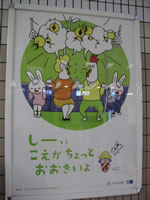
Advertising: Another great thing about the Japanese subway systems are the advertisements! They are always interesting. This poster here isn’t an advertisement, but rather a reminder that people keep their conversations quiet on the train so as to be courteous to those around them.

Empty Subway: I took this photo because it was the emptiest I had ever seen it. Usually there are swarms of people everywhere making their way to their destination.
Intro to Nanoscience Lectures
Professor Bird presented information on semiconductor band gap engineering and also on graphene as a transistor. For semiconductor band gap engineering, he explained how using a combination of two semiconductors, a heterostructured material, could lead to a shortened band gap. Being able to control the band gap of a material can lead to better technologies in many fields including optics, terahertz oscillators, and solar cells. Specifically in optics, these technologies lead to changing the absorption or emission of light in a given device. In his discussion of graphene, he discussed what separated graphene from other semiconductors. The electrons in graphene act as photons and have no band gap. This is a difficult characteristic to work with in transistors because no outside voltage is required on the material for a current to flow. Because of this, graphene transistors can never be switched off and this leads to difficulties in quality device fabrication. However, bilayer graphene exhibits an effective band gap and this material shows more promise than single layer graphene. Though a band gap does exist in bilayer graphene, it is a very small band gap and doesn’t look to be too promising unless a way to dilate the band gap becomes available.
Maruyama-sensei talked about his work with carbon nanotubes. He discussed synthesis and characterization. He also talked about P-N junctions that were very interesting. I feel like progress in this area will lead to many more fields of study in carbon devices. Ishizaka-sensei provided an interesting look into the life of a woman in a Japanese research environment. I was unaware just how few women and foreigners pursue science here and feel very luck that I should be so blessed to have such a diverse department back home.
Kyushu was entirely different than Tokyo. It was lush and green with mountains that touched the sky. The cool country air was refreshing after two weeks in Tokyo. I slept very happily under a pile of blankets next to an open door listening to the quiet sounds of the frogs croaking to each other under the starlight. I think that the calm country has left the biggest impression on me. I didn’t expect to love the country side as much as I thought I would; or more precisely, I didn’t think I would miss it as much as I did. I definitely had fun with the kindergarteners and the high school students, but that beautiful landscape took my breath away every time I looked outside. Honestly, my expectation of the trip was that the country side would be a very poor area. Something that would make me sad to see. But Kyushu was nothing like that. It was beautiful and spectacular, and that beauty was perfectly mirrored in the people that lived there.
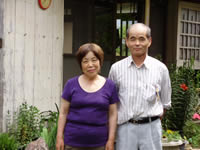
The Fujitas: These people were the kindest, most genuine, hard-working, sweet, and wonderful people I have ever met; and that’s an understatement.
My homestay family was definitely a perfect example of that beauty. The Fujitas were completely wonderful. I had unfortunately fallen ill during the trip, and the couple showed me so much love and care making sure I was okay. I was so shocked that they would so willingly offer their hearts to me, a stranger to their culture, language, and land. I think what I enjoyed most was talking with them about life. It was also the most difficult part of the trip. The language barrier made it difficult to convey ideas, but with a little broken English and the help of a dictionary, the concepts got across. It was wonderful to listen to their take on life. I think that late night conversation will stay with me for a long time. I hope that I will be able to one day give a young student the same kind of opportunity. As for the cultural aspects that Packard-sensei mentioned, I didn’t see any of the behavior that I thought I would. The Fujitas reminded me a lot of my grandparents. She ran around preparing food and ruling the house. She would yell at him to help her in the kitchen, and he would hop up immediately to assist. At one point during the night, he said that she ruled and protected the house; he just lived there. They treated me as if I were their own granddaughter and doted over me constantly. I learned many things at my homestay, but I suppose the thing that will help me most during the rest of the summer was that no one follows the cultural norms. The younger crowds are bringing in new cultural attributes and the members of the older generation were once rebels as well. I can’t read a book and treat people the way the book tells me to. I need to interact with everyone as a human being and stop clinging to a guidebook of generalizations.
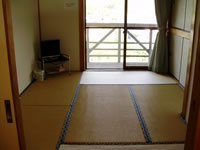
The Inn: This is a picture of my room at the Inn we stayed at the first night at Kyushu. I shared this room with two other people. It was a tight fit once we laid the futons down, but it was actually a pretty comfortable experience. It was a bit odd to me at first that we had to pull the bedding out of the closet and assemble our bedding ourselves. The next morning we also had to refold everything we used and put everything back in its original position in the closet. However, as off-beat as that was for me, it was made up by the fact that the owner of the hotel prepared a huge dinner and breakfast for us.
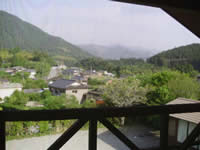
Kyushu: This was the view from my room in the Inn. This beauty is everywhere you look. I loved every new view I took in while in Kyushu. The place is just gorgeous.
Orientation Program Overview
The most helpful experience I had was using the subways. They can get very confusing very quickly and using them frequently on cultural trips and exploring escapades made navigating much easier. I can’t think of an experience that hasn’t been helpful in some way though.
The most helpful thing in the language classes were the take home worksheets. They really helped reinforce the concepts in class and were great practice for reading and writing hiragana. The least helpful thing in the classes was the constant changing of teachers. I think that had only one teaching style been introduced, I would have taken much more from the class than what I did in these few weeks. Another critique I have is that we never learned any real lab related words or phrases like, “Help! I’ve spilled acid on me!” The three strategies I have for studying the language were similar to those I have used before in other language classes: practice, challenge, and relax. When I practice, I use my skills in real world situations. When I challenge, I try to read Japanese signs. Even though I don’t understand, I still increase my reading abilities. Relaxing is something that I do with every topic I come across. Stressing about something makes it harder to learn for me. So I remember to sit back and let the topic sink in before allowing myself to have a panic attack when I don’t understand a concept.
The most important thing I’ve learned since coming to Japan is not related to Japanese culture in any way. But, what I’ve learned is that I can survive. I’m highly self-sufficient and my instincts are pretty good. This gives me a lot of confidence for the years to come, especially when I think about doing research. You need a bit of confidence about you when you’re doing an experiment. Too much self-doubt leads to someone else doing your work for you.
3 Questions about Japan
Why is everyone so obsessed with their dogs? I know it’s not a big deal, but the amount of dog clothing stores concerns me.
How is Japan so safe? I see little kids running around everywhere unsupervised. What’s the difference in the American system and the Japanese system that makes it so safe for young children to walk and play on the streets of Tokyo?
Why does no one cook eggs completely? I get that raw eggs are consumed a lot, but when they’re cooked, the eggs are still runny. Why is this?
Intro to Nanoscience Lectures
Professor Stanton split his discussion into two presentations. The first presentation covered semiconductors and their structures. By studying the band gaps of semiconductors, it can be more fully understood and thus manipulated to service the needs of an experiment. For example, mirco-lasers and quantum dots can be fabricated more easily than they could be in decades past. He also discussed why semiconductors must be used when looking at photovolatics. This is due to the fact that metals reflect the light and do not absorb the energy from the light source. However, semiconductors allow for photons to penetrate their surface and rather than the electrons being ejected from the system, as they are in metals due to the photoelectric effect, the electrons are moved into the conduction band. This change in electron location allows for light energy to be absorbed and converted into electrical energy. These advances in semiconductor science is allowing for better light diodes as well. Since semiconductor LEDs are not held by the same constraints as traditional metal LEDs, those being produced can be bent and twisted without breaking. The semiconductor LEDs allow for a longer lifespan and as LEDs do not generate heat, semiconductor devices begin to look more appealing as eco-friendly devices. His second lecture focused on femptosecond spectroscopy. He compared the techniques that he uses in lab to capturing photographs of a running horse. With this ultrafast spectroscopy, he can capture movements at an atomic level. In this way we will come to learn more about how atoms interact with one another and how we might be able to manipulate the process.
Otsuji-sensei talked about graphene and its uses in terahertz technologies. The possibility of probing space using terahertz telescopes became a reality when he showed pictures of space anomalies. The traditional cameras used to photograph the phenomena showed what seemed to be a large black cloud floating through space. However, the terahertz lens was able to capture the true identity of the so called cloud. He also discussed the use of terahertz technology as scanners that would ultimately be of higher quality and safer exposure rates than the X-ray technology we currently use. He discussed the zero band gap structure of graphene and went on to discuss some synthesis methods of graphene. These synthesis methods included mechanical exfoliation, CVD growth, and another method in which graphene could be obtained through thermal decomposition. He ended by stating that graphene terahertz lasers are a quickly approaching technology that will be extremely useful in future scientific advances.
The first day at lab was pretty cool. Skylar and I were assigned cubicles and shown around the labs. Since we’ll be working with class 4 lasers (the most dangerous type) we had to go get a baseline eye exam. We didn’t really have an orientation to the lab other than touring them rather quickly. There was a new laser coming in that day and everyone seemed to be pretty excited about it. I watched the laser get assembled for a little while and then went and read articles in my cubicle for a few hours as my grad students really didn’t have anything for me to do other than watch a video on laser safety. As the week progressed, more work came my way. By Friday, I had worked a full shift and now have something to my name here in the lab.
In the lab, my supervisor is Pete. He seems to be a likeable chap and I think we’ll get along well as the summer progresses. Pete is very proactive about getting me involved in the lab. When we were in the clean room, he would show me a procedure and then have me repeat it. Once we’re both confident with my performance, I should be able to run the process by myself. I have also worked with Andrew a little bit since arriving. He and I used to work together when I first started research back in 2012. I’m hoping to get a little experience running the experiments he does with MoS2 growth via CVD. The other people in my lab are friendly and easy to talk with.
Here at OIST, English is the official language. Because of this, I think my Japanese skills are going to suffer rather than improve. On the positive side, this allows for easier communication in the lab and will hopefully lead to better work performances. I have tried to use a little Japanese here and there, and am always met with a shocked expression followed by, “You know Japanese?” To which I reply, “Chotto.” While the main language used in lab is English, the staff here uses Japanese primarily. Maybe I’ll be able to practice my language skills with them when I’m not working, “48 hour days.”
My housing situation is just awful. I wake up every morning to a private room that is large and spacious and stroll out into my living room to a panoramic view of the ocean. I make breakfast in my perfectly sized, fully furnished kitchen and then sit at the dining room table to eat. I simply watch the waves come in while I drink my glass of milk and wonder why the ocean can’t pick just one color to be. This nonsense of being every shade of blue and teal makes it seem like the ocean is just trying too hard to be beautiful to every viewer. Compared to a cramped, noisy dorm room back home, I’d say this place is pretty much the same. :)
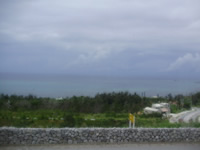
The View: It was rainy when I took this photo, but you can sort of see the gradients of blue I was trying to explain. You will never fully understand the struggle living with this kind of view can be unless you experience it for yourself.
Don’t get me started on the commute either. I have to walk to work every day along a covered pathway that winds through peaceful nature. At night, I don’t get to see the verdant hills and sparkling water ways, but instead am tormented with clear skies, the sounds of distant wave breaking upon the shore, and local frogs singing to a complex melody words fail to describe. OIST is still under construction though, so hopefully, things will start to get better. ;)
I have started working on my project and am excited to be doing so. Once I get through with all the training I need, I’ll be able to access the lab whenever I want. The goals of my work are pretty straight forward and seem to be reasonable. I hope that something comes from the amount of work I’ll be doing, but even if it doesn’t, at least I’ll have gained the laboratory experience.
Research Project Overview
During my time here at OIST, my main project will be fabricating terahertz antennas. These antennas will emit terahertz frequencies when a powerful light source interacts with them. They will then travel through an apparatus that will then detect those terahertz frequencies. This sort of work has been done before successfully with Gallium Arsenide, however this project will attempt to utilize a different material. I also have another project in which I will be constructing the terahertz sensing apparatus. If there is time during the summer, I will also assist on projects involving chemical vapor deposition (CVD) and Raman and photoluminescence spectroscopy.
This week’s assignment is difficult for me to address as I’ve yet to encounter any cultural faux pas. I’ve avoided such instances by observing and then doing. I read the culture articles we were given and kept them in mind as I traveled about the country. I stay quiet and inconspicuous so that I might blend into the crowd. Granted, I do this at home too when I go to new places. I try not to stick out like a sore thumb. I’ve encountered many people from all different kinds of backgrounds, and I can’t really recall a time where I’ve offended anyone on accident. Or, if I have, they were not vocal about it so I remained ignorant. However, I have a duty to report culture differences to the public so instead, I will instead recount my recent adventure to the supermarket.
“How to Have a Semi-Successful Trip to the Grocery Store without Losing your Mind”
Obtain transportation: Here at OIST, you can reserve a car for 24 hours at a time. However, there are only 5 available so I had to book one about a week in advance to my trip. I ended up getting one of the electric cars. (See photo below.)
Make sure the car’s emergency brake is not on. Seriously, that will slow you down a few minutes if you don’t realize what’s going on.
Drive! It’s actually not that bad driving on the left side of the road. I was told many times to go when there was a lot of traffic so that I could get the hang of driving. However, Saturday mornings on Okinawa seem to equate to light traffic. It was really easy getting to the store.
Fun fact! Okinawa (I don’t know if this applies to the rest of Japan) does not have a turn signal on traffic lights. You just sit at the traffic light in the turn lane and when it turns green, you have to use your best judgment on when to turn. But for the most part, everyone follows the speed limit to the kilometer, so turning is less of a nightmare than you’d imagine.
Grab yourself a cart and dive in! There’s really not much more to it. Unless you’re fluent in Japanese, shopping is going to be an adventure every time. You’re not sure what you’re putting in your cart, but it looks interesting. The best aisle (and by far most dangerous) is the candy and snack aisle. You are going to get lost looking at all the new candy you can find. There are some American treats hidden in amongst the pick, but the overwhelming quantity of Japanese sweets can be overwhelming. You will buy(t) off more than you can chew. (Get it?)
Check out. So, I should have mentioned this before you left for the store, but ah well, live and learn. At check out, you should present the clerk with some reusable bags. He or she will put all of your things away nice and organized for you free of charge. However, if you don’t have bags with you, don’t worry. For a small charge to your bill, they will provide plastic bags (usually about 3 yen per bag).
Navigate home. The best way to get home is by going the way you came and not veering off the path because you could get very lost very quickly. You might think, “Hey, is that my exit? It sure looks like my exit.” If you have that thought, you should probably take that exit. Not that I would know from experience or anything like that.
Congratulations! You have gone to a grocery store in Japan! All that’s left is figuring out what you bought and how to cook it. Unless you just bought sweets. In which case, eat up!
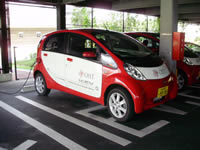
Transportation: This was my sweet ride for my Saturday trip. Since it’s electric, you can’t go more than 60 km without having a recharge (or at least that’s what the guy at security told me). Luckily for me, the store isn’t that far so the charging wasn’t an issue.
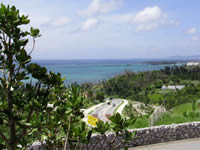
Left Side: Sadly, there was no traffic when I took this picture from my apartment, but you can see that the roads look the same. You just drive on the opposite side. Though, I will admit, the ease at which I drive on the left side concerns me. I don’t know what that says about my driving skills back home.
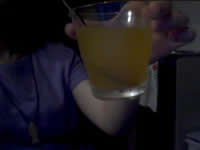
“Never do know what you’re gonna get.”: Mama had it right. I bought what I thought was going to be orange juice (due to the pictures, katakana, and English translation on the sides of the box), but instead was treated to a light citrus flavored beverage. The spoon is in the glass so that you can see just how clear this “orange” juice was.
Research Project Update
This week I was assigned the task of designing and creating my own terahertz detector. I’ve never worked with optics before, but I’m more than willing to take on the challenge. It’s a very basic set-up though I need to draw the schematics in AutoCAD and make sure we have everything in lab that will be required for building. Once all the parts are in, I will spend a few days setting up and aligning the mirrors. After that, I should be ready to test actual samples in it. But for now, it’s just a breadboard.
My antennas are coming along nicely, though lift-off processes have gone a bit awry. The substrates and antennas are waiting to be coated with silicon dioxide right now. Once this step is completed, we will be able to move on to the final stage of development and then go straight into testing the devices. I will most likely end up making more devices in an identical manner to the ones that have been made thus far.
OIST is an international institute that is very much Americanized, so really, there aren’t many “rules” to follow other than the obvious (be professional, wear clothes, etc…) People here address each other on a very informal basis, though you will hear a traditional “-san” added to the end of someone’s name every now and then. Whenever people disagree, it’s taken care of in varying types of ways as there are many different cultures at work here. Everyone seems to get along fine and all have tea time at the restaurant on Thursdays (those are the best because a) free tea and coffee and b) free cakes!)
My NanoJapan Alumni mentor described this place very well. Everything here is very relaxed as he said. The talks that were given in the NanoJapan program were geared toward a more traditional laboratory setting and so weren’t very helpful upon my coming here. There’s still plenty of Japanese culture and mannerisms that I follow on a day-to-day basis such as driving, greeting the front desk, and so on. The work ethic here in Japan is one that’s kind of strange. At OIST, results and effort are the most appreciated. However, I have heard from a few sources that in Japan the effort you put into your work is what’s valued - not the results. I was told that Japanese pay checks are determined by “life achievements” and that the further you are along the road of life, the better off you are. These pay raises come with significant birthdays, getting married, and even having children. To me, this seems a bit odd as it takes away from an equal working environment and encourages women to get married and start families (which means quitting their jobs to stay at home) and that seems to take away the right to live your own life happily. The US is much different in the fact that the results you get on an assignment are what matter. You can wait until the last minute to do something, but as long as you get a result, you’re fine. In Japan, it seems to be the reverse in the fact that you could put in weeks of work into a project that never gets finished, but so long as you tried, you’re fine.
Since OIST doesn’t have any “rules” (again, aside from the obvious), I can’t really share an anecdote about them. Instead, I will share one about the push to get more international students into Japanese institutes:
I was sitting in a group meeting and it was announced that a VIP member of a political party was coming to visit the labs. As the special day approached, you could hear little side conversations asking if anyone knew who was coming to visit and why. It was the Monday morning before the visit that Skylar and I found out who it was that was going to visit OIST. We also found out that the VIP wanted to chat with the two of us and the two EAPSI students that are at OIST this summer. We had to keep it a secret until the next day. Tuesday morning at ten o’ clock, Skylar and I were racing to Lab 1 in order to make our meeting on time. We got there with plenty of time to spare and a few pictures were snapped of the four of us as we stood waiting for this VIP to come down the stairs and greet us. It was fairly obvious when the escorts and guards started lining the stairs that she was headed our way. She came down the stairs talking with the President of OIST in hushed tones and finally stopped in front of the group of students. Ambassador Kennedy shook our hands and greeted us kindly. She asked about our research and then I got a little sassy. We took pictures and that was that. The reason that we met with her (and not other students) was due to the fact that we were all funded by the NSF. The institute wanted her to see that the programs that have funded our stays here in Japan are well worth the expenditures and should continue to be offered. So, I guess I acted as a spokesperson for international science and that’s pretty boss if you ask me.
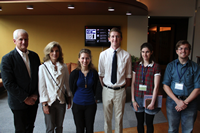
Ambassador Kennedy: As you can see, we’re already best friends, the Ambassador and I. I mean, why else would she willingly choose to stand next to me? I’m sure I’ll be getting an invite to a swinging party at her house soon.
Research Project Update
Huge setback in the lab this week. Lost almost everything that I’ve been working on for the past 3 weeks here. Good news is that the three important samples were not damaged whatsoever and actually look to be useable still. Other than that setback, the wheels are finally moving so that I might become independent in lab by Monday afternoon. Right now, my work schedule relies on my supervisor being there at all times. Hopefully, this won’t be too much of an issue after all the paperwork is pushed through and I’m given full access to the areas and equipment that I need. I’ve been given 3 projects while I’m here and it’s a bit much now that all of them are needing to be finished within a few short weeks, but as long as I put in some long nights here and there, everything should be okay. Other than that, research is going swimmingly and I’m excited that my three sets of antennas will be finished on Monday afternoon. I can only hope that nothing else goes wrong.
Many of my accomplishments have been all research based this summer. I’ve grown used to shopping on my own and living on my own for some time now. Cooking meals every day is actually something I enjoy, and even that’s become very research based (I do quite a few experiments to see what will taste good. So far this plan hasn’t backfired too horribly). I guess my greatest accomplishment has to be speaking up for myself. In lab meetings, if something isn’t going well, or if I need help, I no longer hesitate to ask for it. I simply tell my PI what’s going on and he helps me resolve the problem. Seeing as I started the summer out being spoken over, it’s nice to know that I’m being heard now.
My biggest challenge this summer has been learning the research. I am completely new to terahertz technology and optics which I feel has been made painfully obvious in lab. Everyone in lab views optics as second nature, and I’m floundering about trying to figure out if I should use this mount over another. However, it is actually very nice to have Skylar here with me as the boy lives and breathes laser lab. He’ll come in and see me struggling, give me a tip and then suddenly everything starts working out. I apparently did a ‘no-no’ the other day while I was trying to align my set up. Skylar came in and started laughing at the scene and then came back a few minutes later with a solution I didn’t even know existed. Optics are very hard for me to visualize and set up, but I’m slowly learning and I’m hoping to have something out of it by the end of the week (typhoon allowing that is).
Having three projects to work on is a bit much; however, it’s kind of nice to always have something to do. I haven’t done much CVD growth or Raman/PL scanning, but I hope I’ll be able to pick that skill up before leaving. My detector is coming along nicely and I am hoping that nothing more will need to be done to it once it’s all set up, but I highly doubt that will be an option. My third project is coming along slowly, but hopefully I’ll be able to get something out of it soon; be they positive or negative results.
For the sake of future applicants, here are my top five issues with Japan/Okinawa:
There are no Frosted Flakes. You may think that what you’re buying is good old fashioned American Frosted Flakes, but you will be so very sadly disappointed when you bite into pure corn flake substitute.
Doughnuts. If it looks like a doughnut, smells like a doughnut, and is named, ‘doughnut,’ you’d think it would be a doughnut. You would be wrong. Oh, so very wrong. They aren’t bad, they are just not what I’d call a doughnut. Just be warned, okay?
The internet hates me. I don’t know if anyone else has issues with the internet as badly as I do, but getting a stable connection is very rare here in Japan. Luckily, my apartment has decent wifi if you stay within 15 feet of the router, but going anywhere else in Japan proves very difficult to find wifi.
You have to take the It’s-better-if-I-don’t-ask attitude with your food. If you want to know what’s in your food, have fun as someone tries to explain what you’re eating. Sometimes, they’ll know the English word, other times, they won’t. And sometimes, it really is just better if you don’t know what it is you’re eating.
I love it here. I don’t know if I’m going to be able to go back to America after this wonderful trip. Yes, there have been issues and times where I just wanted to curl up and lay still in a corner by myself, but even now, I’m trying to figure out how I can come back here. I’m typing this report as I watch large waves cropping up on the normally calm surface of the sea. A category 5 typhoon is headed toward Okinawa right now, and I think to myself, “I could get used to this. No worse than tornado alley life.” Aside from the language barriers, I think I could live here quite comfortably.
I just noticed that 3/5 of my issues were food related. Ah well, the public should know.
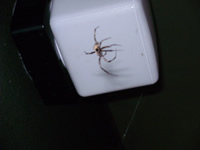
“Another Challenge”: Yet another challenge I face in Japan is getting used to the friendly nature of the creatures here. This lovely specimen wove me a beautiful face mask one morning and I very rudely tore through it in my haste to get to work. Needless to say, he was upset. But soon started working on another masterpiece (though this time, not right in front of my door.)
Research Update
Research is coming along at the speed of science. That is to say, it’s going slowly and painfully. But having done research before, I knew that this is about what it would be like. I spent an entire day on an alignment today, and as soon as the set up was aligned, I pulled my arm back and knocked over a mirror that I’d forgotten to bolt down. I just stood there for a moment in disbelief at what I’d just done. I tried to fix the problem quickly, but soon gave up when I saw the time. Wanting to beat the storm, I left my work for another day when walking home an hour later wouldn’t be considered risking my life. I think I’ll have the set up built and aligned by the end of the week. It might be a bit ambitious, but that’s kind of my MO. I’ll be working on my poster this week as well and I hope that there isn’t a lot of white space that needs to be filled.
Learning Japanese has been difficult. Not for a lack of effort either. Since coming to Okinawa, my language skills have suffered. I’ve been swept away in my research and have neglected to continue in my Japanese studies. I’m a little disappointed by this, since I really wanted to learn the language before coming. I think that had I taken classes prior to this program, it would have been much better. There was so much information in those short 3 weeks at orientation and none of it really stuck with me. Even during classes I struggled to construct sentences and pronounce things properly.
Being in Okinawa, I haven’t come across any linguistic barriers. I go to the store and know what I want beforehand. I am able to ask clerks where items are and they usually will take me there themselves without saying a word. In the labs, I work mostly alone calling in the occasional bits of advice from my British mentor. Having the linguistic skills would be very nice, but I’m in the rural area of Okinawa, so when headed out on an excursion, I always know where I’m going, what I’m doing, and the key phrases that I know I will need.
The Mid-Program Meeting was filled with a lot of sleeping for me. I unfortunately fell ill and so, my recollection of the meeting is a bit biased. I did enjoy hearing about everyone else’s lab experiences though. It was quite surprising that some people hadn’t even started on a project as of yet. It made me realize that I am so very lucky to have the advisor I do, as he has fought alongside me to get a project started as well as get me some independence in the lab. I will spend the next two weeks rushing to get at least one of my projects working, and will then travel to Osaka and spend a few days exploring the surrounding areas. I’m a little shocked at how quickly the summer has gone by, but after trudging back from work today after spending several hours of prep work only to find a piece of equipment wasn’t working and I couldn’t do the procedure today, I am actually a bit relieved to see the end of the summer. It has been exhausting, but extremely rewarding.
Also, typhoons are ridiculously boring. Just be sure to stock up on food and water and have a book to read on stand-by. I watched the whole storm from my living room window and sent messages to my family to let them know I was alright. I was expecting a bit more from the typhoon, but overall, I’m glad that it was a boring storm. Being from the mid-west, a boring storm means less damage to recover from and that’s reassuring.
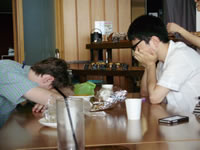
Meetings are Exhausting: I snapped this picture of two participants sleeping during lunch. I completely understand guys. Meetings are hard.
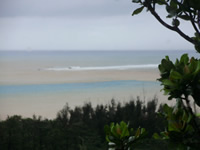
“Your eyes are like the ocean after a storm…” That compliment apparently means murky, yellow, and an extremely choppy with pretty big waves. The next time someone offers this compliment, you may want to set up an appointment with your optometrist.
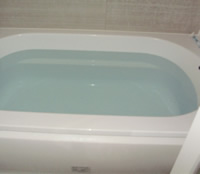
Only in Okinawa. As you can see, the water here is blue. My roommate and I were prepping for the typhoon and filled the bathtub up with water. I had to ask her to confirm that the water was actually blue. Then, I took a picture to confirm. The bathtub is white and the walls are purple-gray, so I’m not sure where this beautiful color came from.
Research Update
This past week, my research has been interesting. Another batch of samples has been ruined and I’m not entirely sure why as the procedure was followed precisely. However, despite the samples being trashed, my other project seems to be promising for right now. I have my optics set up and learned how to align a delay stage. I didn’t really expect to finish a project in the short amount of time I was here, but the knowledge I’ve gained working in both fabrication and optics is completely wonderful and I’m so glad I’m getting this experience. I’ve learned how to use maskless lithography, evaporation deposition, and ICP CVD systems in fabrication. And I’ve learned the basics of optics, set up, and alignment. Hopefully, in these next two weeks of research, I’ll pick up some information on terahertz generation.
Alright, this week we’re supposed to read about a scientist here in Japan by the name of Haruko Obokata. She’s a biologist who started off with a very promising career and suddenly has lost all of her credibility. She was working with stem cells and claimed that an acid bath would revert cells to their embryonic state, thus creating cells that could be manipulated into growing into a different type of cell. However, claims were put against her research accusing her of false data, picture manipulation, and phony research. After an investigation, it was discovered that the research was indeed fabricated and thus she lost all credibility as a scientist.
What I don’t understand about her story, is her claim to be so passionate about science. If she truly cared about the science, would she not have just worked at getting the actual results rather than fabricating them? Science should be about improving technology quickly, not just putting out research first. Especially in her field, it seems ridiculous to me that she would lie because there are people who would suffer from her mistakes. If she truly cared about the science, she wouldn’t have lied about the results. It sounds to me as though she was trying to make a name for herself.
The second part of this that I don’t understand is why everyone is focusing on the fact that she is a female. I get that there aren’t a lot of female scientists, and I understand that in Japan those numbers are even less than in the states. But the fact that the reports focus on the fact that she’s female just puts a bad rap on the women scientists who are out there. Yes, she faked results, but that’s not because of her gender. Many male scientists have faked results too and lost just as much credibility. Perhaps she did do it to gain prestige among her colleagues and prove that being a woman doesn’t limit her abilities, but reading through the articles, it sounds as though she was plenty respected and held a lot of potential in her career. Who knows why she did what she did? The fact of the matter is that the results were faked and it was found out before too much time was wasted on trying to duplicate results.
This story makes me a little sad, actually. The fact that she’s only getting this attention because of her gender just re-enforces the idea that women can’t do scienc e- that they have to cheat to get ahead. Honestly, science is a very competitive field. You want to get the data out there first. You want to make your name be seen and your work revered. However, there’s no use in faking it because you’ll eventually get found out-despite your gender. She was being made into a poster girl for women in science. She was supposed to inspire girls to do something other than go to college to find a husband. And yet, she lied and set back- if not entirely ruined- her career and the dreams of the girls that looked up to her. True heroes are hard to find in this world, and when or if you find one, it’s very hard to take when they fail you. Society idolizes them until they make a mistake. It’s a shame really that this inspiring woman is now the focus of a lot of negative press.
Okinawa Life Update: This weekend is a three day weekend for Umi no Hi (Ocean day!) Saturday I spent as any typical college kid would and slept about and rested my legs for a day. Sunday (today as I’m writing this) I had access to a car and drove down to the Yomatin Pottery Village. It’s a small village comprised of 45 artists. They literally open the doors of their homes and invite you in to look at and purchase their art work. There was a lot of beautiful artwork there, however, I was on the hunt for shi-sa (Okinawan idols that bring happiness to any household they guard) and was also on a tight budget. My camera did the very technology thing to do and died before I could get any pictures of this village, so I apologize for the lack of images.
Speaking of pictures…
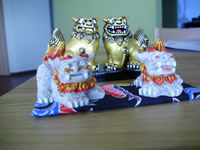
Shi-sa: I was successful in finding shi-sa not once, but twice! The one with the open mouth is the male and he attracts happiness. The one with a closed mouth is the female and she maintains the happiness. You see these everywhere in Okinawa and it is the number one thing to buy as a souvenir. Only one pair of these guys is mine (the front) and the other pair was requested by a dear friend.
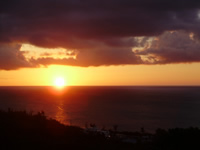
Ocean Day: Seeing as it’s a national holiday, I thought I’d share a picture of a beautiful Okinawan sunset with you lovely folks. Tanoshi umi no hi des! (Please excuse the Japanese if it’s incorrect. I’m trying to say ‘Happy Ocean Day!’)
Research Update
As I’m entering my final week of research, I’m just trying to wrap up loose ends. I have obviously not completed any project while I was here due to the short time I was allowed. However, I have learned a lot of things about optics and terahertz that I didn’t know before and hopefully, I’ll be able to use in the future. Speaking of terahertz, I was able to build a spectrometer and successfully detect terahertz. I’ll be spending the remaining week here optimizing the signal and working on my poster and abstract.
Alright folks, we’re nearing the end of my time in Japan. However, I am glad to say that I’m nowhere near the end of my research. Though, after talking with some Japanese researchers at OIST, I am very disheartened to know that many of their careers are. See, being a woman opened up a lot of doors for me to get in on conversations that men aren’t allowed to hear. I learned a very sad fact that in general, Japanese women go to college to find a husband. I was floored. My roommate told me at one point during the summer that a girl in her lab was going to quit her work when she was thirty so that she could get married and start a family. While I can understand why she would want to settle down, I cannot understand why she would put so much work into such a hard field of study, simply to throw it all away.
However, seeing as OIST is chalk full of all sorts of different nationalities, here are some top hits of the differences I’ve noticed:
The U.S. is way better about allowing undergraduates to be involved in research at an earlier age. Many other countries don’t allow undergrads into labs until their 4th years, if at all.
Hierarchy within the labs. The U.S. sort of has one, but it is not as strict as other countries. Obviously in Japan, there are titles that are given to professors of certain rank (-san, -sensei, etc.), and while that may not be true for all countries, there is definitely a division between the PI of a project and the undergrad minions doing the grunt work.
Apparently U.S. undergrads are more likely to get put on papers/presentations. I think this might be due to the fact that U.S. students are involved on projects for longer stretches of time.
Though, while there are differences, there are also similarities. So I’ll list those to even the odds.
Women are a rarity. Seriously, across the globe finding women in science is like finding a flock (herd?) of unicorns. Okay, I’m exaggerating a little there. But really, the number of women in science compared to men is quite small.
Science is awesome and people get excited about it! Really. No matter where they come from, there is always a very intense interest in what kind of science is going on in the world around them.
There are international collaborations everywhere. They may not have a lot of international workers, but there are overseas collaborations and that’s actually kind of nice to hear.
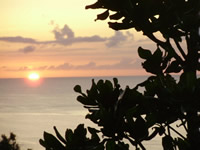
Last Sunset: Ah, my very last sunset in Okinawa. I can’t lie, I’m really going to miss this island. Aside from the heat and every animal (except the feral cats) having the potential to kill you, it is a fun little place to drive around on.
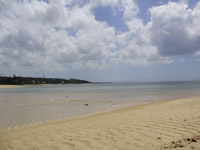
Last Beach Day: I had to say goodbye to the beach. That was indeed a very sad day; especially when the tide came in and I was stranded. Luckily, I was able to get myself out of that one without having to swim (and thereby ruin my camera). Goodbye Okinawa.
Research Update
As can be expected with short term research, things went south and there was no coming back from it. I finally finished my terahertz spectrometer; however, I could not actually get any kind of signal out of it because the laser sort of died on me. It became very unstable and was due for an alignment and cleaning - both of which were unable to happen quickly enough for me to even attempt getting a better signal that what I originally was able to find. But, all in all, the research was definitely a learning experience and I took a lot away from it. I am looking forward to the next week just being able to relax and enjoy exploring Kyoto and the surrounding areas. I’ll be in Tokyo next week talking about everything I’ve done this summer. I do hope that is goes over well.
The thing that’s changed the most during my time here are my perceptions of countries. I used to think that Japan was a very traditional society with very strict rules. However, after living here for 11 weeks, I’ve found that while the traditional aspect of Japan is alive and strong, the lifestyle isn’t super strict either. The people here are very forgiving of cultural faux pas and would rather teach you their ways than scold you for not knowing them. Though, living in Japan, I’ve also heard the phrase, “That would never happen in America.”
Which, of course, means my views toward my homeland have changed as well. While I miss the comforts of comfort foods, I don’t miss the anxiety of misplacing items. Here in Japan, you can literally lose anything and it will be turned into the local authorities. Back home if you misplace an iPod, a dollar, anything, someone will walk off with it. Japan also has the added benefit of being ridiculously safe. You can leave everything unlocked and never worry about being robbed. America, not so much. I don’t know that I would feel safe walking alone in a big city in the US, however, I felt perfectly fine exploring Kyoto solo. Really, I think I’m most impressed by the differences in safety than anything else.
Personally, I don’t know that I’ve changed except for the fact that I’m much more sure of myself now than I was before coming. I’m confident in my choices and I’m not constantly double checking directions all the time. In fact, directions have somewhat been thrown out of my life. If I want to go somewhere, I just look up the general location and hope for the best. Even if I don’t find the place I’m looking for, it usually ends up as a good story.
I think what I’ll miss most about Japan is the sheer beauty of the place - from the scenery to the people. Working in Japan, I won’t miss too terribly much. As I was at OIST, I did not get the full experience that everyone else seems to have gotten. I never hung out with my lab mates on weekends, I never had the stress of trying to appease to a Japanese mentor, nor did I have to deal with the frustration of a language barrier. Though, I did have quite a bit of an experience and have taken a lot from it. The most important thing is that no matter how much you hound people for help, ultimately, you have to figure it out for yourself. It’s going to be heartbreaking when they come in and tell you your work is wrong and then take it apart without fully explaining what’s wrong (though you did ask), but eventually, it will all start to make sense.
My career goals and attitude towards education remain the same, though; I am a bit more excited to explore more fields of Physics than just material science. While I don’t think optics is really my forte, I did enjoy learning about and generating terahertz. I’d kind of like to see what else there is in the field and see if I can’t apply my knowledge in more ways.
My final week in lab was nothing special. I tried desperately to finish my project and poster, but due to constraints on the laser system, couldn’t actually get any data. The fact that I was leaving was actually ignored until the Wednesday of my departure. We ended up having a nice dinner at a restaurant for all the leaving interns before I left.
As for my final weekend in Japan, I climbed Mount Fuji. My advice for everyone who thinks this would be a fun trip: don’t. Just don’t. Go do something else - anything else. Fuji is a serious mountain and people train for it. It’s a 5-7 hour hike in the dark in the cold and once you get up there, you just watch the sunrise. Then, you have to hike back down on a horrible slope for 3-5 hours with sleep deprivation. So while it will make a cool story in years to come, don’t risk your life. Go sleep with the monks instead.

Ohayou gozaimasu!: Here you can see the sun breaking through the morning clouds from the top of Mt. Fuji-san. As soon as the sun was seen, you could hear nothing but a deafening roar of ‘ohayou gozaimasu!’ ringing out from the mountain side. It was actually kind of terrifying and surreal to hear the cries go out. Though, I suppose after climbing all night, I can understand why seeing the light of day would be exciting.
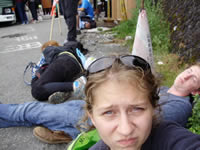
13 hours later… I was sitting at the bus stop minding my own business when two other NanoJapaners came up and said, “You look so awake! Make sure we don’t get run over by any busses!” They then collapsed on the ground and promptly fell asleep. I guess a 13 hour climb wears some people out.
Research Project Overview
Project Title: ![]()
Femotosecond Spectroscopy Group, Prof. Keshav Dani, Okinawa Institute of Science & Technology
Research
Mentor: Peter Hale
Introduction: For the duration of the NanoJapan internship, two projects were conducted: the first involved the use of MoS2 as a terahertz emitting substance instead of GaAs for interdigitated antennas, and the second focused on the design and construction of a time-domain spectrometer. MoS2 was chosen as the terahertz emitting material as it shows promise as a photoconductor due to its direct band gap and fast recombination time, both of which are important factors in generating terahertz waves. Both chemical vapor deposition (CVD) and liquid-phase exfoliation techniques were used to obtain single to few layer MoS2. The second project was done concurrently so as to eventually test the MoS2 antennas and see if any signal could be found.
Approach: The MoS2 antennas were made using maskless lithography, evaporation deposition, and Inductively Coupled Plasma Chemical Vapor Deposition (ICP CVD). Lift-off techniques using photoresist and acetone were also utilized during the initial fabrication. Processing techniques included resistance testing and wire bonding.
When building the spectrometer, previous designs used in the lab and in literatures were studied and a new design was created in AutoCAD. The spectrometer was then constructed and aligned using techniques particular to the laboratory in which the construction was carried out.
Results: The MoS2 antennas were unable to properly be tested as many of the samples burned in ICP CVD giving too few data points to actually render a result of any kind. The spectrometer was able to detect terahertz from a working GaAs antenna that had been made previously. The initial scan was able to find 0.5THz without optimization or purge.
Discussion: When looking at the antennas in a microscope, it is clear to see there are some issues that arise when using MoS2 as a photoconducting material that need to be looked into more carefully. One such issue is the liquid-phase exfoliated material does not fall evenly into the gaps of the interdigitated antennas nor does it completely cover the width of the antenna branches. This may be due to the drop casting techniques used to place the MoS2 onto the antenna. Other methods may be better suited for covering the antenna such as evaporation of the isopropylnol so that the nanoflakes of MoS2 fall more evenly onto the substrate. The second issue involved the ICP CVD stage in fabrication. Many samples burned during this step and so very few MoS2 antenna were actually able to be fabricated. This could be resolved by using another deposition technique, though I hypothesize that the substrate used (Si/SiO2) was not a thermically ideal material and thus resisted cooling during the deposition. Because the substrate didn’t cool properly during the deposition, the sample became too hot and thus burned the photoreisit permanently to the surface of the antennas.
The spectrometer was unable to be optimized due to an instability in laser power that arose and could not be fixed during the time allotted for this project. The spectrometer was able to detect terahertz and thus can be used as a detection device for the MoS2 antennas should the issues in the ICP CVD process be resolved.
Future Work: The next steps in this project are to resolve the issues with ICP CVD, create more antennas, and produce a photocurrent from the devices. Once all of these steps have been completed, the antennas will then go on to be tested as terahertz emitters.
There are two additions that should be included in the spectrometer. The first of which should be a purge box to eliminate absorption of the terahertz by water vapor. The second project would be to add in a secondary pathway for the generation beam so that the system can be used in both transmission and reflection emission.
Conclusion: The ultimate goals of these two projects were to create working antennas using MoS2 and to build a spectrometer that would be capable of detecting terahertz. While the antennas could not be fully explored during the limited time of the project, work on the antennas will be continued and a full set of data will be collected to determine whether or not this material is a viable source of terahertz generation. As complications arose with the laser being used for the spectrometer, the system was never able to be fully optimized. However, with the addition of a purge box, it can be expected that more terahertz will be detected. With a stable laser, it can also be expected that more accurate results will be able to be optimized and analyzed. Work on these projects will continue with the study of photocurrents in MoS2
How to explain the experience to a family member: “It was Japan-y.” I’ve told multiple members of my family this exact statement a few times by this point. I don’t really know how to express all 12 weeks in a succinct 2-3 sentence summary. I could say it was wonderful, but then they ask me why and my only real answer is that I liked the culture. Which I then have to explain that ancient culture in 2-3 succinct sentences and the trend continues on. I didn’t have any big magical Hollywood scenes with fireworks and music and a choreographed dance while I was there. I simply lived and living isn’t all that exciting to hear about. It’s difficult to explain to family members the difficulty and feeling of success just to find yeast in the grocery store. It’s hard to compact every growth and experience into 2-3 sentences and so, I keep it very simple. “It’s exactly as you would imagine Japan to be.” And that seems to work, because my family doesn’t care too much for the science portion of what I did, rather the cultural experience. I have talked about Japan to them, however, it seems my sentences start with, “In Japan…” rather than, “I did this…”
How to explain the experience to a professor: NanoJapan was an excellent opportunity to work in a different environment as a temporary member. In a permanent position, it’s very easy to establish your place in lab, however, as a visiting member, it’s difficult to work your way into the social dynamic of the group and can be a hindrance to scientific research getting done in a timely manner. When coming into a group that does research in a different field than what you’re accustomed to, it also is difficult to convey what you don’t understand. I often found myself lost in a problem and when I would reach out for help, it seemed as though I was being batted away. “Figure it out,” was often the answer I was given to a problem. However, what no one seemed to understand is that I didn’t understand the answers I was finding. In the end, I did end up gaining a lot of knowledge about optics and dealing with an established group of researchers as a temporary member.
How to explain the experience to an employer: That experience was such a fantastic opportunity for me. I learned to deal with many problems on an international scale. I learned understanding and compassion - things that I thought I understood, but realize now that I didn’t understand them at all. I was an American in Tokyo for three weeks wandering about without strong language skills. I found myself often wanting someone to just be kind and excuse my American ways. When working in an international lab, I learned about fitting into an established group temporarily. I picked up some knowledge on optics through hands-on learning and self-learning. I also learned about being able to work alone as I was often left to work by myself in the lab. I had to be very careful around the laser apparatus as it was a class 4 laser (the most dangerous class of laser) and had to be very responsible for my own actions on a whole new level. If I were to leave my arm in the laser beam too much, my arm hair could have caught on fire and I would have to have been the one to answer for that. As there was no established work schedule, I was responsible for putting in the appropriate amount of hours into work. I had to turn in my time sheets at the end of the summer and was very conscious of the hours I was working. I also learned how to work with people of different nationalities. Though I was in Japan I was working in an international institute on Okinawa and within the group I was working for, 8 different countries including China, Japan, and Greece were represented. I learned how to work with each culture in a seamless manner and was able to avoid causing any kind of conflict within the lab while I was there.
How to explain the experience to a student: Do it! Go learn to live! I always had a desire to explore and learn in a different country, but now, surprisingly enough, I want to explore my home too. It was a phenomenal, though demanding program. While there you get to experience so many wonderful sights and events, however, you’re also doing roughly 8-5 days of language class and culture or science lectures for three straight weeks. You learn a lot about Japanese culture, but you learn a lot more about yourself. You learn how to enjoy your time off and how to explore an area multiple times with new eyes. During your 8 weeks of working, you learn how to feed and take care of yourself. You learn how to live alone and how to get up and get ready in the morning. You learn what you’re made of and whether or not you can troubleshoot life problems. It’s a fantastic time and even though it can be trying sometimes with jet lag and exhaustion, it’s a nice experience that you should try to get involved in.
What changed about me: I’m not worried about getting lost anymore. I used to have to know every turn and direction when I was going somewhere. I would map out areas, hop onto google earth and see where I was going before I actually left. Whenever a wrong turn was made, my stomach dropped. However, driving on Okinawa without a reliable cell phone, I learned to explore on my own and go to places that I’d not been before. If I made a wrong turn, it was no big deal. If I found a military base before the beach, it wasn’t a big deal because I’d also found some old castle ruins to play on in the area. I really noticed this change when I was driving to school. I always want to take the wrong exit on my way to college and this time on my way down, I was doing the trip solo. I started to feel the panic a little bit, but then it hit me that I’d gone around on an island without good language skills or a cell phone and had made it out alive. I felt so much better and continued driving. As I’m writing this from my dorm room, I think it’s safe to say that I made it here alive and well.
As for right now, I’m not sure if I want to do another study abroad program or not. That may just be because I’m still tired from my travels, or because that long flight is still very fresh in my memory. Maybe next summer I’ll attempt another IREU or I may just go explore the country I’m in now as even living in another state can be an experience in itself.
I loved my time in Japanese culture. Though I may not have had the best of times all the time, it was definitely a good experience to get out and see the world through new eyes.
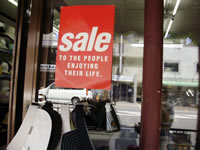
Advertising: While this store was trying to sell hats, I think the advertisement can be used for anybody wanting to travel to Japan- or travel to anywhere else in the world. Go out and enjoy your life. ‘Sale’-ebrate if you will.
With this, I bid you all adieu. It has been a fun 12 weeks.
Daily Life in Okinawa: Okinawa didn’t really result in a Japanese living experience. There was a language barrier outside of OIST, though having only one Japanese member in our group, that barrier didn’t affect my life. Hearing the stories from the other NJers, I actually felt a little bit cheated on this experience. Yes, I was in Japan, however, I never dealt with the hierarchy that others did, nor did I hang out and explore with my lab mates. Okinawa is a very Americanized culture and so, I cannot accurately describe the lifestyle.